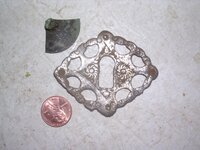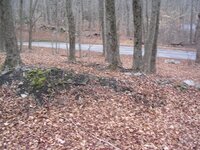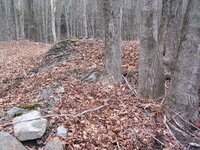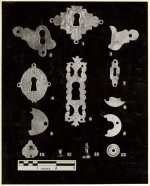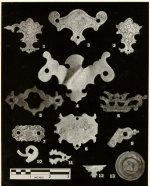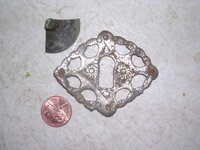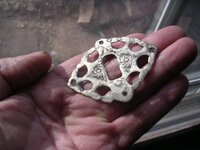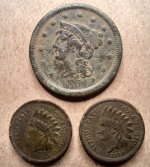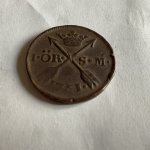CTwoods
Sr. Member
For the Colonial New England "relic" guru's...
Scrambling to choose the best spot in case winter arrives; I went yesterday and today to a well known big cellar/mill, barn damsite on town property, 5 minutes from home.
There has been dug iron all over this huge site for decades, but I always find many non ferrous targets missed or ignored by the high tone Big Copper skimmers.
Late yesterday, I found this "burn pile" of bricks and charcoal. Don't know what it was, or how it got piled in two spots, but an inch or two down, got a broken Tombac...so it shows the entire site may be at least 1700s. Brought a clam rake and a 5" coil setup today, but the pile froze solid over night!
Tried to find a remote field across the road that shows as pasture in the 1934 Aerial Photo online. Never found "the old field", but the stonewalls looked better even farther out. Don't have a GPS to find my way back out so I went back to do a last run on the cellar side again.
Got this escutcheon at quitting time. Figured it would be a factory stamped brass sheet type from somewhere in the last part of 1800's, until I cleaned it. Took a few minutes to spot the design of the two side flowers were not the same, then realized it is totally handmade and a tube shape punch was used to make two sizes of circles, and the half circles by holding the punch crooked.
I sanded it to bring out the detail and it is not brass; I think it is a Tombac type zinc alloy, as it is not a yellow brass color, nor a copper color.
two nail heads are rusted in place. I suppose it could be for furniture, but I am thinking a small lock-box for sugar, coffee or tobacco? IDK
No idea how to date it, but it must be colonial IMO, and could go way back as the site is within 2 miles of the original 1670 village
I have two unusual whatzits from the burnpile that I will clean and post later in ID.
I was having a pretty downer day till I got home to clean my stuff. I am pretty happy with this find
Scrambling to choose the best spot in case winter arrives; I went yesterday and today to a well known big cellar/mill, barn damsite on town property, 5 minutes from home.
There has been dug iron all over this huge site for decades, but I always find many non ferrous targets missed or ignored by the high tone Big Copper skimmers.
Late yesterday, I found this "burn pile" of bricks and charcoal. Don't know what it was, or how it got piled in two spots, but an inch or two down, got a broken Tombac...so it shows the entire site may be at least 1700s. Brought a clam rake and a 5" coil setup today, but the pile froze solid over night!
Tried to find a remote field across the road that shows as pasture in the 1934 Aerial Photo online. Never found "the old field", but the stonewalls looked better even farther out. Don't have a GPS to find my way back out so I went back to do a last run on the cellar side again.
Got this escutcheon at quitting time. Figured it would be a factory stamped brass sheet type from somewhere in the last part of 1800's, until I cleaned it. Took a few minutes to spot the design of the two side flowers were not the same, then realized it is totally handmade and a tube shape punch was used to make two sizes of circles, and the half circles by holding the punch crooked.
I sanded it to bring out the detail and it is not brass; I think it is a Tombac type zinc alloy, as it is not a yellow brass color, nor a copper color.
two nail heads are rusted in place. I suppose it could be for furniture, but I am thinking a small lock-box for sugar, coffee or tobacco? IDK
No idea how to date it, but it must be colonial IMO, and could go way back as the site is within 2 miles of the original 1670 village
I have two unusual whatzits from the burnpile that I will clean and post later in ID.
I was having a pretty downer day till I got home to clean my stuff. I am pretty happy with this find
Attachments
Upvote
10


